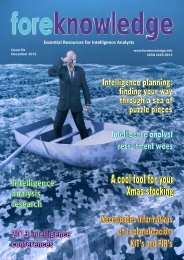Download in PDF (2MB) here - Foreknowledge
Download in PDF (2MB) here - Foreknowledge
Download in PDF (2MB) here - Foreknowledge
Create successful ePaper yourself
Turn your PDF publications into a flip-book with our unique Google optimized e-Paper software.
Analytic rigour<br />
The previous pages stressed how important it is that we as analysts are honest <strong>in</strong> our th<strong>in</strong>k<strong>in</strong>g, analysis and communicat<strong>in</strong>g the<br />
threat to our clients. A few scholars and practitioners are now develop<strong>in</strong>g methods and tools to enhance m<strong>in</strong>dfulness and rigour <strong>in</strong><br />
our quest to provide <strong>in</strong>sight and foresight to clients. In this issue we look at Daniel Zelik et al’s rigour model which tries to answer<br />
the question:<br />
“How can <strong>in</strong>telligence analysts ensure that they have been rigorous <strong>in</strong> the analytical process?”<br />
How far beyond simply collect<strong>in</strong>g and<br />
list<strong>in</strong>g data did analyst go?<br />
Low: Compiled a unified form<br />
High: Integrated with thorough consideration<br />
of diverse <strong>in</strong>terpretations<br />
8. Explanation critiqu<strong>in</strong>g<br />
7. Information synthesis<br />
Were the perspectives of doma<strong>in</strong> experts<br />
<strong>in</strong>cluded <strong>in</strong>to the assessments?<br />
Low: No effort to seek out expertise<br />
High: Experts have been consulted<br />
How many different perspectives were <strong>in</strong>corporated<br />
<strong>in</strong> exam<strong>in</strong><strong>in</strong>g the primary hypotheses?<br />
Low: Little use of other analysts<br />
High: Peer & expert review on<br />
cha<strong>in</strong> of reason<strong>in</strong>g with strong<br />
and weak <strong>in</strong>ferences clearly <strong>in</strong>dicated<br />
Does the analyst consider and<br />
understand the assumptions<br />
and limitations of their analysis?<br />
1. Hypothesis exploration<br />
5. Sensitivity analysis<br />
Were multiple hypotheses considered<br />
<strong>in</strong> expla<strong>in</strong><strong>in</strong>g data?<br />
Low: m<strong>in</strong>imum weigh<strong>in</strong>g of alternatives<br />
High: Multiple perspectives to<br />
identify the best & most probable<br />
explanations<br />
toolbox<br />
3. Information validation<br />
4, Stance analysis<br />
6. Specialist collaboration2. Information search<br />
Low: Explanation seems valid on<br />
surface<br />
High: Analyst has strategy to consider<br />
strengths of explanations if support<strong>in</strong>g<br />
sources were to prove <strong>in</strong>valid<br />
Dalene Duvenage<br />
The depth and breadth of the search process<br />
used <strong>in</strong> collect<strong>in</strong>g data.<br />
Low: Rout<strong>in</strong>e and readily available data sources<br />
High: Exhaustively explore all data<br />
The levels at which <strong>in</strong>formation sources are corroborated<br />
and cross-validated.<br />
Identify the stance or perspective<br />
of the source and<br />
plac<strong>in</strong>g it <strong>in</strong>to a broader<br />
context for understand<strong>in</strong>g<br />
Low: Analyst notice bias <strong>in</strong> source<br />
High: Research <strong>in</strong>to source background to understand<br />
how their perspective might <strong>in</strong>fluence<br />
their stance<br />
Low: No effort to verify source accuracy<br />
Based on Zelik, Daniel et al 2007. Understand<strong>in</strong>g Rigor <strong>in</strong> Information Analysis papers <strong>here</strong>, <strong>here</strong> and <strong>here</strong><br />
High: Systematic approach to verify<br />
<strong>in</strong>formation and w<strong>here</strong> possible use<br />
source closest to issue<br />
October 2012 <strong>Foreknowledge</strong> 13



